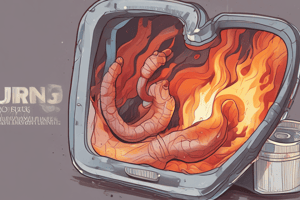Podcast
Questions and Answers
What percentage of the body does the front of the chest account for in the Rule of 9s?
What percentage of the body does the front of the chest account for in the Rule of 9s?
- 27%
- 4.5%
- 9% (correct)
- 18%
In the assessment of thermal burns, what is the priority action regarding inhalation burns?
In the assessment of thermal burns, what is the priority action regarding inhalation burns?
- Maintain a patent airway (correct)
- Apply topical creams
- Start intravenous fluids
- Administer analgesics
Which type of burn requires monitoring of cardiac rhythm due to its nature?
Which type of burn requires monitoring of cardiac rhythm due to its nature?
- Thermal burns
- Radiation burns
- Electrical burns (correct)
- Chemical burns
What type of feeding is emphasized in the nutritional management of patients with MODS and SIRS?
What type of feeding is emphasized in the nutritional management of patients with MODS and SIRS?
What is the main difference in the skin of geriatric patients that affects burn severity?
What is the main difference in the skin of geriatric patients that affects burn severity?
What is the first-line fluid management for burn patients?
What is the first-line fluid management for burn patients?
What is the role of proton pump inhibitors in the care of MODS and SIRS patients?
What is the role of proton pump inhibitors in the care of MODS and SIRS patients?
Which action is advised for ensuring home safety among geriatric patients to prevent burns?
Which action is advised for ensuring home safety among geriatric patients to prevent burns?
Flashcards are hidden until you start studying
Study Notes
Burns
- Burn Chart (Rule of 9s): Used to estimate the total body surface area affected by a burn.
- Head: 9% (4.5% front, 4.5% back)
- Chest: 18% (9% front, 9% back)
- Arms: 9% each (4.5% front, 4.5% back)
- Chest/Stomach: 18% (9% each)
- Back: 18% (9% each, upper and lower)
- Legs: 18% each, front and back (9% for each)
- Perineum: 1%
- Priority Assessment for Burns:
- Thermal Burns: Assess location and severity.
- Inhalation Burns: Maintain a patent airway
- Determine Cardiovascular Status: Pulmonary artery pressure = arterial line
- Chemical Burns: Caused by chemicals like drain cleaners, hair dye, and relaxers.
- Electrical Burns: Caused by appliances, lightning, or powerlines.
- Two points: Entry and Exit
- Monitor Cardiac Rhythm
- Thermal Burns: Assess location and severity.
- Fluids for Burns:
- Administer Lactated Ringer's solution before Normal Saline.
- Burn Wound Care:
- Emotional Support: Reassure the patient.
- Analgesics: Administer morphine before wound care.
- Types:
- Escharotomy: Performed in 4th degree/full-thickness burns.
- Gentle Cleaning and Debridement: Remove dead tissue and debris.
- Nutrition for Burns:
- High Protein: Critical for tissue repair.
- Daily Weights: Monitor fluid loss.
- Geriatric Burns: Increased vulnerability to burns:
- Home Safety:
- Smoke Detectors: In front of every bedroom.
- Carbon Monoxide Detectors: Down placement.
- Candle Placement: Proper use and placement.
- Cooking Precautions:
- Old Appliances: Check for faulty wiring.
- Differences in Burns:
- Thinner Skin: Increased risk of deeper burns.
- Dehydrated Skin: Impacts healing.
- Decreased Vascularity: Limits oxygen delivery to tissues.
- Home Safety:
- Patient Care for MODS and SIRS:
- Care:
- Sterile Technique: Prevent infections.
- PPI (Protonix): Prevent ulcers.
- Surgery: Debridement for necrotic tissue.
- Early Ambulation after Surgery: Prevent atelectasis (collapsed lung).
- Remove Urinary Catheters ASAP: Minimize risk of infection.
- Dialysis: For patients with kidney failure.
- Nutrition:
- Enteral Feedings/High Caloric: Support healing and energy needs.
- SIRS (Systemic Inflammatory Response Syndrome): Life-threatening inflammation.
- Labs: Blood culture to identify infection.
- MODS (Multiple Organ Dysfunction Syndrome): Caused by SIRS, leading to organ failure.
- Family Support: Therapeutic communication.
- Care:
Studying That Suits You
Use AI to generate personalized quizzes and flashcards to suit your learning preferences.




